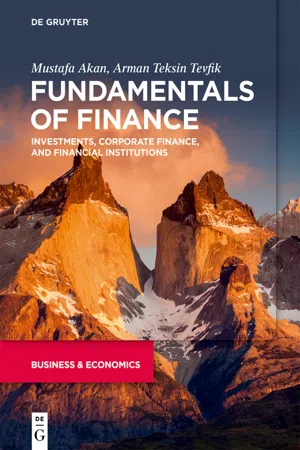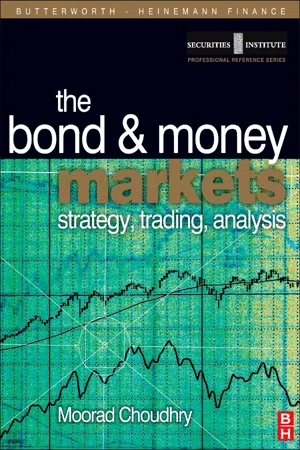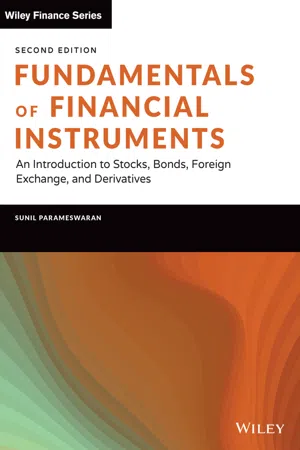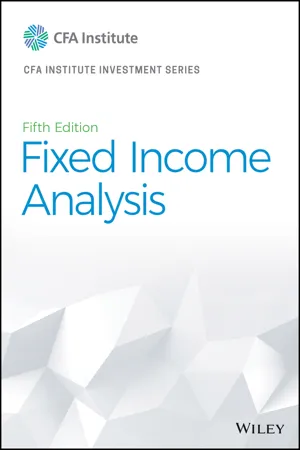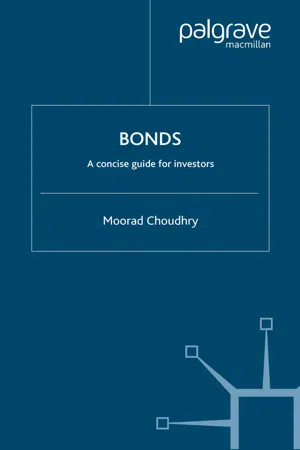Business
Bond Terminology
Bond terminology refers to the specialized language used in the bond market to describe various aspects of bond issuance, trading, and valuation. Key terms include face value, coupon rate, maturity date, yield, and credit rating. Understanding bond terminology is essential for investors and financial professionals to effectively analyze and trade bonds.
Written by Perlego with AI-assistance
Related key terms
1 of 5
10 Key excerpts on "Bond Terminology"
- eBook - PDF
Fundamentals of Finance
Investments, Corporate Finance, and Financial Institutions
- Mustafa Akan, Arman Teksin Tevfik(Authors)
- 2020(Publication Date)
- De Gruyter(Publisher)
4 Bonds and the Markets 4.1 Introduction Bonds dominate debt securities markets. Thus, we will dwell on bonds rather than other debt securities. Time value of money principle is used extensively in bond val-uation. Generally, bonds have contractually-based fixed cash flows, a known time to maturity, and a known principal value at maturity. We first review bond charac-teristics and the global nature of the bond market. The second part of the chapter discusses valuation principles for bonds and the risks faced by bond investors. Duration and convexity are the major tools used to measure bond risks. Bond port-folio performance is also discussed. 4.2 Bond Terminology and Features of Bond Markets This section discusses various terms associated with bonds and institutional fea-tures of bond markets. Other topics examined include bond income and strategies, global bond markets, and bond ratings. Bond Terminology A bond is a debt agreement that a corporation or government agency (i.e., munici-pality) enters into when it wants to borrow money for more than five years. In the following section, we present important terms for bonds: – Par value is the face value of a bond, the principal to be paid at maturity. – Coupon rate is annual interest divided by face value. Coupon rate times face value equals the coupon interest payment. – Maturity date is the final date on which repayment of the debt principal is due. – Indenture is a legal agreement detailing the issuer ’ s obligations pertaining to a bond issue. – Debenture is an unsecured, long-term corporate bond. – Subordinated debenture is an unsecured bond in which payment will be made to the bondholder only after the holders of senior debt issues have been met. – Call feature is an option that allows the firm to pay off or call a debt issue prior to maturity. – A sinking fund provision requires the issuer to retire specified portions of the bond issued over time by using the fund. - eBook - ePub
The Handbook of Traditional and Alternative Investment Vehicles
Investment Characteristics and Strategies
- Mark J. P. Anson, Frank J. Fabozzi, Frank J. Jones(Authors)
- 2010(Publication Date)
- Wiley(Publisher)
CHAPTER 4Bond BasicsIn its simplest form, a bond is a financial obligation of an entity that promises to pay a specified sum of money at specified future dates. The payments are made up of two components: (1) the repayment of the amount of money borrowed and (2) interest. The entity that promises to make the payment is called the issuer of the security or the borrower. We provide the basic features of bonds and the risks associated with investing in this asset class in this chapter. In subsequent chapters we provide details on specific sectors of the bond market.FEATURES OF BONDS
In the following sections, we describe the basic features of bonds.Maturity
Unlike common stock, which has a perpetual life, bonds have a date on which they mature. The number of years over which the issuer has promised to meet the conditions of the obligation is referred to as the term to maturity. The maturity of a bond refers to the date that the debt will cease to exist, at which time the issuer will redeem the bond by paying the amount borrowed. The maturity date of a bond is always identified when describing a bond. For example, a description of a bond might state “due 12/15/2025.”The maturity of a bond is used for classifying two sectors of the market. Debt instruments with a maturity of one year or less are referred to as money market instruments and trade in the money market. What we typically refer to as the “bond market” includes debt instruments with a maturity greater than one year. The bond market is then categorized further based on the bond’s term to maturity: short-term, intermediate-term, and long-term. The classification is somewhat arbitrary and varies amongst market participants. A common classification is that short-term bonds have a maturity of from one to five years, intermediate-term bonds have a maturity from five to 12 years, and long-term bonds - eBook - PDF
- Moorad Choudhry, Graham "Harry" Cross, Jim Harrison(Authors)
- 2003(Publication Date)
- Butterworth-Heinemann(Publisher)
Let us examine some of the key features of bonds. 2.1.1 Type of issuer A primary distinguishing feature of a bond is its issuer. The nature of the issuer will affect the way the bond is viewed in the market. There are four issuers of bonds: sovereign governments and their agencies, local government authorities, supranational bodies such as the World Bank, and corporations. Within the corporate bond market there is a wide range of issuers, each with differing abilities to satisfy their contractual obligations to investors. The largest bond markets are those of sovereign borrowers, the government bond markets. The United Kingdom government issues gilts . In the United States government bonds are known as Treasury Notes and Treasury Bonds , or simply Treasuries . 2.1.2 Term to maturity The term to maturity of a bond is the number of years after which the issuer will repay the obligation. During the term the issuer will also make periodic interest payments on the debt. The maturity of a bond refers to the date that the debt will cease to exist, at which time the issuer will redeem the bond by paying the principal. The practice in the market is often to refer simply to a bond's ``term'' or ``maturity''. The provisions under which a bond is issued may allow either the issuer or investor to alter a bond's term to maturity after a set notice period, and such bonds need to be analysed in a different way. The term to maturity is an important consideration in the make-up of a bond. It indicates the time period over which the bondholder can expect to receive the coupon payments and the number of years before the principal will be paid in full. The bond's yield also depends on the term to maturity. Finally, the price of a bond will fluctuate over its life as yields in the market change and as it approaches maturity. - eBook - PDF
Bond and Money Markets
Strategy, Trading, Analysis
- Moorad Choudhry(Author)
- 2003(Publication Date)
- Butterworth-Heinemann(Publisher)
If our example bond paid its coupon on a semi-annual basis, the cash flows would be £2.50 every six months until the final redemption payment of £102.50. Let us examine some of the key features of bonds. ■ Type of issuer A primary distinguishing feature of a bond is its issuer. The nature of the issuer will affect the way the bond is viewed in the market. There are four issuers of bonds: sovereign governments and their agencies, local government authorities, supranational bodies such as the World Bank and corporations. Within the corporate bond market there is a wide range of issuers, each with differing abilities to satisfy their contractual obligations to lenders. The largest bond markets are those of sovereign borrowers, the government bond markets. The United Kingdom government issues bonds known as gilts . In the United States government bonds are known as Treasury Notes and Treasury Bonds , or simply Treasuries. ■ Term to maturity The term to maturity of a bond is the number of years after which the issuer will repay the obligation. During the term the issuer will also make periodic interest payments on the debt. The maturity of a bond refers to the date that the debt will cease to exist, at which time the issuer will redeem the bond by paying the principal. The practice in the market is often to refer simply to a bond’s “term” or “maturity”. The provisions under which a bond is issued may allow either the issuer or investor to alter a bond’s term to maturity after a set notice period, and such bonds need to be analysed in a different way. The term to maturity is an important consideration in the make-up of a bond. It indicates the time period over which the bondholder can expect to receive the coupon payments and the number of years before the principal will be paid in full. The 5 Chapter 1: The Debt Capital Markets bond’s yield is also depends on the term to maturity. - eBook - PDF
- Roy E. Bailey(Author)
- 2005(Publication Date)
- Cambridge University Press(Publisher)
12.1 What defines a bond? The prototypical bond is a contract that commits the issuer to make a definite sequence of payments until a specified terminal date. For example, the issuer might promise to pay $100 per annum from the present until 30 June 2025, at which time the contract will terminate with a lump sum payment of $1000. An important characteristic of many bonds is that they are commonly bought and sold in secondary markets. In this context, bonds are a special form of loan, which is commonly an agreement between two parties (borrower and lender) that is typically not traded with anyone else. Also, bonds are often long-lived; e.g. twenty or more years from the date of issue is not uncommon. While, in principle, bonds can be issued by anyone, in practice they are issued by governments, their agencies (including supranational bodies, such as the World Bank) and incorporated companies. For companies, bonds provide a way of acquiring capital at a known cost, without sacrificing rights of control over the company if the terms of the contract are fulfilled. In the example above, 30 June 2025 is called the maturity date , the lump sum of $1000 is called the face value (or ‘maturity value’, or ‘principal’) and the sequence of $100 payments are known as coupons . Sometimes the bond would be referred to as a ‘10% bond’, because $100 is 10 per cent of $1000. But, note carefully, there is no particular reason to suppose that the rate of return on the Bond markets and fixed-interest securities 283 bond – however measured – equals 10 per cent. Various ways of defining the rate of return are described in the following sections. The remainder of this section outlines some of the important characteristics that serve to differentiate one bond from another. Bonds can be, and often are, quite complex financial instruments, with all sorts of provisions written into the formal contract – known as the bond’s indenture . - eBook - PDF
Fundamentals of Financial Instruments
An Introduction to Stocks, Bonds, Foreign Exchange, and Derivatives
- Sunil K. Parameswaran(Author)
- 2022(Publication Date)
- Wiley(Publisher)
TERMS USED IN THE BOND MARKET Face Value The face value, also known as Par value Redemption value Maturity value Principal value is the principal amount underlying the bond. It was the amount raised by the issuer from the first holder and is the amount repayable by the issuer to the last holder. We will denote it by the symbol M. Term to Maturity This is the time remaining in the life of the bond as measured at the point of evalua-tion. It may be perceived as the length of time after which the debt shall cease to exist, and the borrower will redeem the issue by repaying the holder. It may also be viewed as the length of time for which the borrower has to make periodic interest payments on the debt. The words maturity , term , and term to maturity are used interchangeably. We will assume that we are stationed at time zero and will denote the point of matu-rity by T. Thus, the number of periods until maturity is T, which is normally measured in years. Coupon The contractual interest payment made by the issuer is called a coupon payment. The name came about because in the earlier days, bonds were issued with a booklet of Valuation of a Bond 137 post-dated coupons. On an interest payment date, the holder was expected to detach the relevant coupon and claim his payment. The coupon may be denoted as a rate or as a dollar value. We will denote the coupon rate by c . The dollar value, C , is therefore given by c × M . Most bonds pay interest on a semiannual basis and consequently the semiannual cash flow is c × M /2. Consider a bond with a face value of $1,000, which pays a coupon of 8% per annum on a semiannual basis. The annual coupon rate is 0.08. The semiannual coupon payment is 0.08 × 1,000/2 = $40. Yield to Maturity Like the coupon rate, the yield to maturity is an interest rate. The difference is that while the coupon rate is the rate of interest paid by the issuer, the yield to maturity (YTM) is the rate of return required by the market. - eBook - PDF
- (Author)
- 2022(Publication Date)
- Wiley(Publisher)
We will also follow this convention, and where any nuance of meaning is intended, it will be made clear. Moreover, the term “fixed income” is not to be understood literally: Some fixed-income securities have interest payments that change over time. 1.1. Overview of a Fixed-Income Security A bond is a contractual agreement between the issuer and the bondholders. Three important elements that an investor needs to know about when considering a fixed-income security are: • The bond’s features, including the issuer, maturity, par value, coupon rate and frequency, and currency denomination. These features determine the bond’s scheduled cash flows and, therefore, are key determinants of the investor’s expected and actual return. • The legal, regulatory, and tax considerations that apply to the contractual agreement between the issuer and the bondholders. • The contingency provisions that may affect the bond’s scheduled cash flows. These contin- gency provisions are options providing either issuers or bondholders certain rights affecting the bond’s disposal or redemption. This section describes a bond’s basic features and introduces yield measures. The legal, regulatory, and tax considerations and contingency provisions are discussed in subsequent sections. Chapter 1 Fixed-Income Securities: Defining Elements 5 1.1.1. Basic Features of a Bond All bonds, regardless of issuer, are characterized by the same basic features, which include maturity, par or principal amount, coupon size, frequency, and currency. 1.1.1.1. Issuer Many entities issue bonds: private individuals, such as the musician David Bowie; national governments, such as Singapore or Italy; and companies, such as BP, General Electric, or Tata Group. Bond issuers are classified into categories based on the similarities of these issuers and their characteristics. - eBook - PDF
- Laurence G. Taff(Author)
- 2002(Publication Date)
- CRC Press(Publisher)
Homeowners pledge their land and the buildings on it. Businesses will also issue mortgage bonds on their land and buildings, but these are not the type of securities considered in this chapter. Bonds have several key features: 1. Their issue amount or the total dollar quantity of the securities sold is not generally purchased by one entity (but might be so in a private placement). 2. Their principal amount, face or par value: $5,000 and $10,000 are the minimum retail denominations commonly available, although one may be able to purchase units as small as $1,000. 3. Their maturity date, term-to-maturity, or due date; maturity date and due date concern when, in the future, the redemption value of the bond will be repaid. Normally this is 10 to 20 years from the date of issue (though the Walt Disney Corp. issued a 100-year bond in 1993). 4. Bonds usually pay interest, at half the stated annual rate, on a semiannual basis, starting 6 months from the issue date. The rate is known as the coupon rate. This interest income is sometimes referred to as coupon income or the nominal yield . 5. The redemption amount, barring default, will be repaid in full on the maturity date. Another name for the standard corporate bond is a bullet bond because the repayment of the relatively large principal amount (compared to a coupon payment) comes all at once. 34 Investing in Mortgage Securities Bonds were once issued on fine paper handsomely engraved. The origin of the terms coupon rate and coupon payment (the latter meaning the dollar amount of each of the semiannual payments, the former referring to the annual interest rate) stems from this earlier era when bonds were physical paper documents instead of just book entries in a computerized ledger. The paper bond had tear-off portions, i.e., the coupons, which the bond holder presented at a payment station (typically a commercial bank) to receive his semiannual interest payments in cash. - eBook - PDF
- Scott Besley, Eugene Brigham, Scott Besley(Authors)
- 2021(Publication Date)
- Cengage Learning EMEA(Publisher)
Check out STUDY TOOLS at the end of this chapter LEARNING OUTCOMES After studying this chapter, you will be able to . . . 6-1 Describe the basic characteristics of debt and some of the different types of debt. 6-2 Discuss bond ratings and the information they provide to investors. 6-3 Explain how bond prices are determined. 6-4 Explain how bond yields (market rates) are determined. 6-5 Describe the relationship between bond prices and interest rates (yields), and explain why it is important for investors to understand this relationship. 6 Bonds (Debt)— Characteristics and Valuation Webking/iStock/Getty Images Plus/Getty Images 124 PART THREE: Valuation—Financial Assets Copyright 2022 Cengage Learning. All Rights Reserved. May not be copied, scanned, or duplicated, in whole or in part. Due to electronic rights, some third party content may be suppressed from the eBook and/or eChapter(s). Editorial review has deemed that any suppressed content does not materially affect the overall learning experience. Cengage Learning reserves the right to remove additional content at any time if subsequent rights restrictions require it. interchangeably to designate the amount that must be repaid by the borrower. Interest Payments. In most cases, owners of (investors in) debt instruments receive periodic payments of inter- est, which are computed as a percentage of the principal amount. But some debt does not pay interest; to gener- ate a positive return for investors, such financial assets must sell for less than their par, or maturity, values. Secu- rities that sell for less than their par values when issued are called discounted securities. Maturity Date. The maturity date represents the date on which the principal amount of a debt is due. As long as interest has been paid when due, once the total principal amount is repaid, the debt obligation has been satisfied. - eBook - PDF
Bonds
A Concise Guide for Investors
- M. Choudhry(Author)
- 2006(Publication Date)
- Palgrave Macmillan(Publisher)
It indicates the time period over which the bondholder can expect to receive the coupon payments and the number of years before the principal will be paid in full. The bond’s yield also depends on the term to maturity. Finally, the price of a bond will fluctuate over its life as yields in the market change and as it approaches maturity. As we shall discover later, the volatility of a bond’s price is dependent on its maturity; assuming other factors remain constant, the longer a bond’s maturity the greater the price volatility resulting from a change in market yields. Principal and coupon rate The principal of a bond is the amount that the issuer agrees to repay the bondholder on the maturity date. This amount is also referred to as the redemption value, maturity value, par value or face amount, or simply par. The coupon rate or nominal rate is the interest rate that the issuer agrees to pay each year. The annual amount of the interest payment made is called the coupon. The coupon rate multiplied by the principal of the bond provides the cash amount of the coupon. For example a bond with a 7 per cent coupon rate and a principal of £1,000,000 will pay annual interest of £70,000. In the UK, USA and Japan the usual practice is for the issuer to pay the coupon in two semi-annual installments. For bonds issued in Euro- pean markets and the Eurobond market, coupon payments are made annu- ally. On occasion one will encounter bonds that pay interest on a quarterly Bond basics 19 basis. All bonds make periodic interest payments except for zero-coupon bonds. These bonds allow a holder to realise interest by being sold substan- tially below their principal value. The bonds are redeemed at par, with the interest amount then being the difference between the principal value and the price at which the bond was sold. We explore zero-coupon bonds in greater detail later. Currency Bonds can be issued in virtually any currency.
Index pages curate the most relevant extracts from our library of academic textbooks. They’ve been created using an in-house natural language model (NLM), each adding context and meaning to key research topics.
